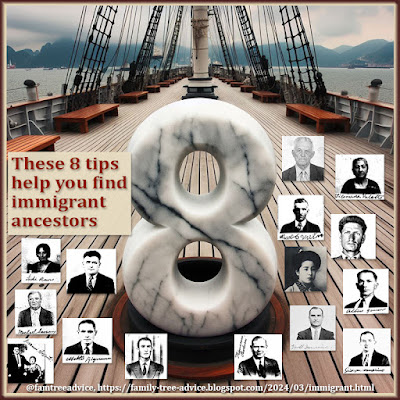Blog reader Steve asked how to find people who were born after available vital records end. Like me, he's dealing with Italian records that aren't online. My towns' birth records end in 1915. His town's online vital records end in 1899. The answer to his question is true for any ancestor's missing vital record.
My grandmother was born in the Bronx, New York, in 1899. She had one sibling born before her in Italy. I have his 15 Dec 1898 Italian birth record, but his death record isn't available. I only know he died before his parents boarded a ship for New York on 3 July 1899.
Grandma's October 1899 birth record is available online from the NYC Municipal Archives. Their website has birth records for her siblings Alfredo (1903), Amelio (1905), and Stella (1908). But I can't get their youngest sister Aida's 1911 birth record. The available Bronx birth records end in 1909. I know Aunt Aida's exact birth date only because her daughter told it to me. I found no U.S. documents that include her birth date. (Find out which certificates are available for each NYC borough.)
 |
| Missing vital records don't have to bring your family tree research to a halt. |
If the records you need are not online, here are 6 places to look so you can extend your family tree.
1. Marriage Documents
The marriage records I've seen from England include only the name of the bride and groom's fathers. How disappointing! Italian marriage records include both sets of parents' names. As a bonus, Italian women keep their maiden name for life. Other countries will vary, but some may contain the detail you're missing.
My 2nd great uncle married in the Bronx in 1902. His marriage record names the towns in Italy where the bride and groom were born. And they're both correct! It also includes all 4 parents' names and addresses for the bride and groom. As for their ages, we get only 21 years and 25 years. Actually, a clerk wrote that part in Italian as "21 anni" and "25 anni."
Sometimes Italian marriage records include a document I call a request to marry. It's actually a request for a couple to publish their intention to marry. In Italian: richiesta di pubblicazione da farsi alla casa comunale. I love this one-page record because it includes:
- all the parents' names, and
- the exact date and town of birth for both bride and groom.
A marriage record may not have the detail you seek, but it can hold enough clues to extend your research. My great grandparents' 1906 New York State marriage record helped me solve a mystery. It lists the bride's mother as Maria Luigia. I used clues from her brother's death record to figure out her full name, Maria Luigia Girardi. To find out how I made this discovery, see "This Expanded Resource Provided an Elusive Maiden Name."
2. Death Records
There will be times when you can find a death record even if you can't find a birth record. In my experience, U.S. death records often get some facts wrong. My 2nd great grandfather Antonio died in New York City in 1925. His eldest son provided the information for the death certificate. The certificate says Antonio's father was Raffaele, and that's right. But it gets his mother's name 100% wrong. The certificate calls his mother Mary Piseo. This led me on a wild goose chase for quite some time.
It was only when I hired a pair of genealogy researchers from Naples that I discovered the truth. I now have an image of Antonio's parents' marriage record. A few months before Antonio was born, his father Raffaele married Grazia Ucci. Who on earth is Mary Piseo? Apparently nobody.
To find out about my experience with hiring Italian researchers, see "Results! Hiring a Professional Genealogist."
Even if the death record you find gets some details wrong, it will get some right. My great grandfather's 1969 Ohio death record includes:
- his correct date of birth
- his wife's correct maiden name
- his father's Anglicized first name (but otherwise correct).
For his mother, they got the first name right, but the informant didn't know her maiden name.
See which clues you can turn into productive research. If nothing else, that death record tells me that Michele Iamarino married a woman named Lucia.
3. Records in their Adopted Country
Vital records don't usually say if someone from Italy went to another country. (Find out what it looks like when a document does tell you they left the country.) When a trail goes cold in the in-country records, it's worth a broad search to see if they emigrated.
If you get lucky and find them on a ship manifest, you may find out their destination. Then you can track down their records in their new country. Even if you don't learn their date of birth, you can discover what happened to them next.
4. DNA Matches and Online Family Trees
One of my cousins bought a DNA kit for her adopted daughter. She got some pretty close matches who pointed us straight to the correct families. Some of her matches had built decent family trees. One in particular has an enormous family tree. This is someone who's clearly interested in documenting her family history. We should all be lucky enough to find a match like her.
If you find the person you need in a family tree, remember everyone else's family tree is nothing but a set of clues. Continue the research for yourself.
Today I found my Aunt Aida, mentioned above, in a stranger's family tree. The tree belongs to a distant cousin of Aida's husband, but they:
- borrowed facts from my tree, and
- managed to bungle Aida's last name.
You have to prove or disprove what their family tree says.
The closest direct ancestor I can't name is one of my 3rd great grandmothers. Her hometown has no records before the 1861 unification of Italy. Even those Italian researchers I hired found practically nothing to document my family. That's why I don't think any other descendant can tell me her name. But if you're looking to ID a 2nd great grandparent or closer, you have a much better chance of finding the clues you need among your DNA matches and their family trees.
5. Archive Records
I wish every genealogy document could be online. I hit the jackpot when FamilySearch digitized their microfilm and the Antenati site came online. The only way I'll ever go further back in my family tree is if all the parish records come online, too. As it is, the earliest direct ancestors I can name were born in the early 1600s. That's amazing for an Italian family with zero nobility in their line.
If the records you need aren't online, you may need to visit or send someone to the archives. I wanted to see my grandfather's military record, and it isn't online. So I visited the Archivio di Stato di Benevento during one of my trips to Italy.
I went there prepared with an Italian sentence or two. I had the register number and the document number I wanted to see along with his name and hometown. This made it easy for the staff to bring me the book, and they gave me permission to photograph the page. They were also kind enough to bring me the book with my grandfather's birth record, and I hadn't asked for it. Even though I'd seen it online, it was exciting to see the original and realize how large these books are. To read about this incredible experience, see "Taking a Do-It-Yourself Genealogy Vacation, Part 1."
If you want to visit the archives in another country, do your homework first. Know the location, their holdings, their hours, and any demands they will make of you. When I went to the New York State Archives in Albany, there was one room where they didn't allow you to bring in a pen. It was pencils only, and a notebook, but no backpacks. The more you prepare, the more productive your visit will be. And if you can't go in person, seek out a reputable researcher in the area. Or, if you're lucky, a cousin may be able to help.
I spend a lot of time getting around missing records. For instance, a birth record may tell me that the baby's grandfather has already died*. If the death record isn't available, at least I know he died before such-and-such a date. I make note of that date so I don't give him any facts that happened after he died.
*On Italian records, a person's name is sometimes followed by their father's name. This helps distinguish between two people with the same name. If the person is Giuseppe Caruso di Francesco, the di means his father Francesco is still alive. But if his name is Giuseppe Caruso fu Francesco, then Francesco has died. Certain birth records from about 1866–1874 tell you the name of the maternal grandfather, too. What a tremendous help that can be!
6. Military Records
I really love U.S. draft registration cards for World War I and II. Sometimes they're your only documentation of a man's date of birth. And if they include a town of birth, it's usually right.
One draft card led me to discover the hometown of my 2nd great grandmother. Another gave me a birth date for one cousin when the vital records for that year were missing. Yet another helped me realize we'd always been wrong about Grandpa's birthday. To see why this is such an important document, read "Why You Need Your Ancestor's Draft Registration Cards."
Be creative. Clues may exist in unexpected places. I found out my 2nd great grandmother was still alive at age 60 in an unusual way. She reported the births of two of her grandchildren in 1901 and 1902. These were completely unexpected discoveries. Remember to leave no stone unturned.




